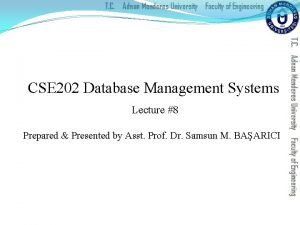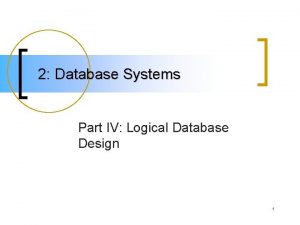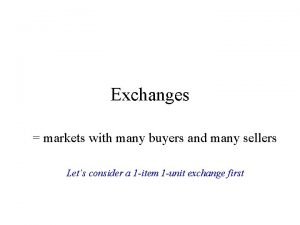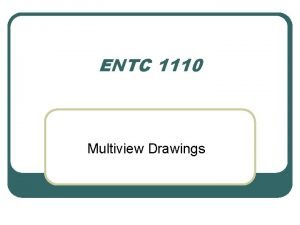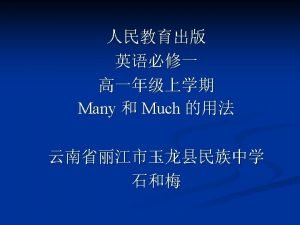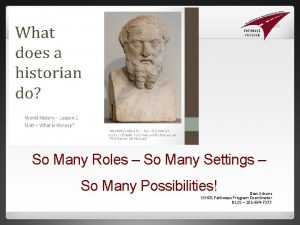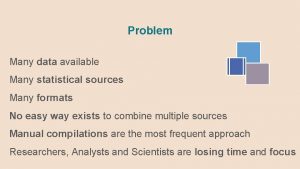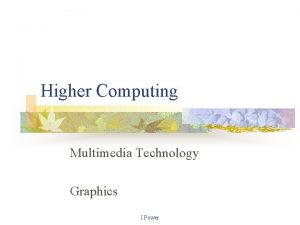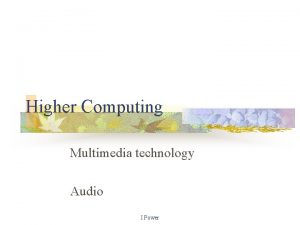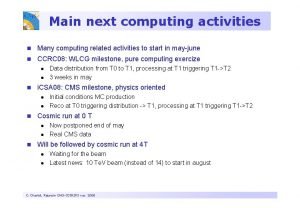Standard Algorithms Higher Computing Standard Algorithms Many algorithms
















- Slides: 16

Standard Algorithms Higher Computing

Standard Algorithms Many algorithms appear over and over again, in program after program. These are called standard algorithms You are required to know about 5 of these algorithms: Input Validation Linear search Counting occurences Finding the maximum value Finding the minimum value

Standard Algorithms What is Input Validation Input validation checks user input to see if it’s within a valid number range. If it’s outside the valid range the algorithm asks for the number again until it falls within the acceptable range.

Standard Algorithms Input Validation Pseudocode 1 2 3 4 5 Get and store value Loop WHILE data is out with range Display error message Prompt user to re-enter value End loop

Standard Algorithms What is Linear Search? Linear search is the simplest search method to implement and understand. Starting with an array holding 8 numbers with a pointer indicating the first item, the user inputs a search key. Scanning then takes place from left to right until the search key is found, if it exists in the list.

Standard Algorithms Linear Search (The search item is 76) Each item is checked to see if it 76, until 76 is found or the last item is checked.

Standard Algorithms Linear Search Pseudocode 1. 2. 3. 4. 5. 6. 7. 8. 9. 10. 11. 12. 13. 14. Set found to false Get search value Start at first element on the list Do while (not end of list) AND (found is false) If current element = search value Then Set found = true Display found message Else Move to next element in the list End If Loop If found = false Then Display not found message End If

Standard Algorithms What is Counting Occurrences Programs often have to count occurrences. Examples include counting the number of: ▪ students who achieved particular marks in an exam ▪ rainfall measurements greater than a particular level ▪ words equal to a given search value in a text file. The basic mechanism is simple: 1. a counter is set to 0 2. a list is searched for the occurrence of the search value 3. every time the search value occurs, the counter is incremented

Standard Algorithms Counting Occurrences Algorithm 1. 2. 3. 4. 5. 6. 7. 8. 9. 10. Set counter = 0 Get search value Set pointer to start of the list Do If search item = list(position) Then Add 1 to counter End If Move to next position Until end of list Display number of occurrences

Standard Algorithms Maximum And Minimum Algorithms Computers are often used to find maximum and minimum values in a list. For example, a spreadsheet containing running times for videos might make use of a maximum algorithm to identify the video with the longest running time, or a minimum algorithm to identify the shortest running time. To find a maximum, we set up a variable which will hold the value of the largest item that has been found so far, usually the first element. If an element in the array exceeds this working maximum, we give the working maximum that value.

Standard Algorithms Maximum Pseudocode 1. Set maximum value to first item in this list 2. Set current position to 1 3. Do 4. If list(position) > maximum Then 5. set maximum equal to list(position) 6. End If 7. Move to next position 8. Until end of list 9. Display maximum value

Standard Algorithms Minimum Pseudocode 1. Set minimum value to first item in ths list 2. Set current position to 1 3. Do 4. If list(position) < minimum Then 5. set minimum equal to list(position) 6. End If 7. Move to next position 8. Until end of list 9. Display minimum value

Standard Algorithm Exam Questions An international athletics competition between eight countries has a number of events. The winning times are stored in a list in order of lane number like the on the right. The stadium needs a program to help process the results. Lane Time (secs) 1 2 3 4 5 6 7 40. 23 41. 05 42. 88 39. 89 40. 55 40. 01 39. 87 Q 1. The program must find the fastest time for a race. Use pseudocode to design an algorithm to find the fastest time (4 marks) Q 2. It is suggested that algorithm should find the lane number of the fastest time instead of the fastest time. Explain how this could be achieved. (1 mark)

Exam Marking Scheme Set fastest to first time in list For rest of array items If array(current)<fastest then Set fastest to array(current) End if End loop In summary, 1 mark for each of the following: • Setting initial value • Loop (with end) for traversal of array • Comparison of current element with maximum value (with end if) • Assignment of new maximum value

Standard Algorithm Exam Questions No. Tow is a company that runs a city centre car park. The company requires a piece of software that will calculate the number of cars on a particular day that spent more than three hours in the car park. The number of whole minutes each car is parked is stored in a list as shown on the right. . 124 210 105 193 157 Q 3. Use pseudocode to design an algorithm to carry out this calculation (4 marks)

Exam Marking Scheme Set over 3 = 0 For each car that day If duration >180 then Add one to over 3 End if End loop • • 1 mark for initialising 1 mark loop with termination 1 mark for if. . endif with correct condition 1 mark for keeping running total Note: End of if/loop may be implicit in clearly indented algorithm The value is in minutes so the condition is > 180
 Advanced higher computing understanding standards
Advanced higher computing understanding standards Bbc bitesize higher pe command words
Bbc bitesize higher pe command words Conventional computing and intelligent computing
Conventional computing and intelligent computing Many sellers many buyers
Many sellers many buyers Relationship chart
Relationship chart Bookstore database design
Bookstore database design Erm vs erd
Erm vs erd Unary many to many
Unary many to many Erd film
Erd film Unary many to many
Unary many to many Many to many communication
Many to many communication Sqlbi many to many
Sqlbi many to many Ternary relationship example
Ternary relationship example Many sellers and many buyers
Many sellers and many buyers 6 principal views of an object
6 principal views of an object On which playing card is the cardmaker's trademark
On which playing card is the cardmaker's trademark The standard error of the mean
The standard error of the mean







